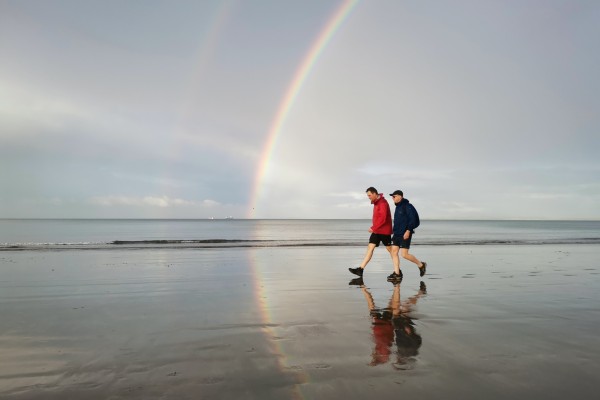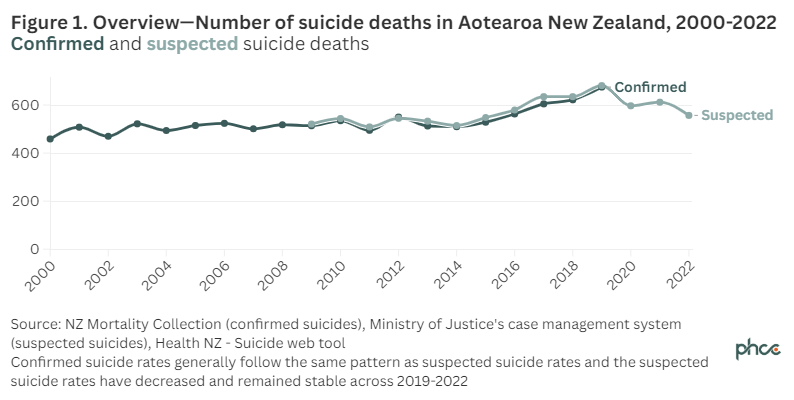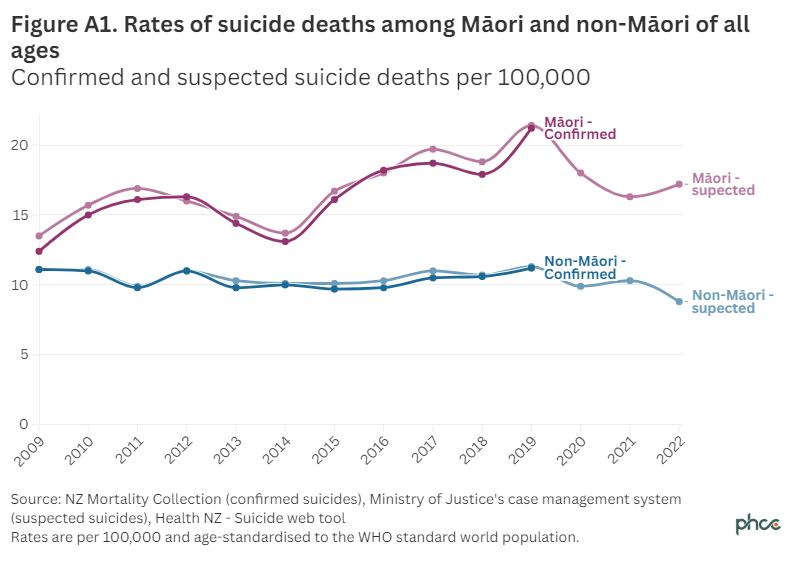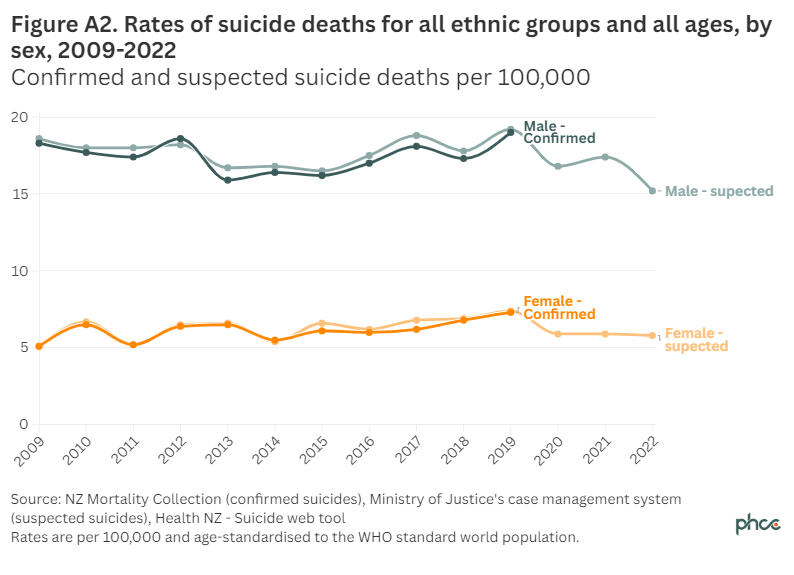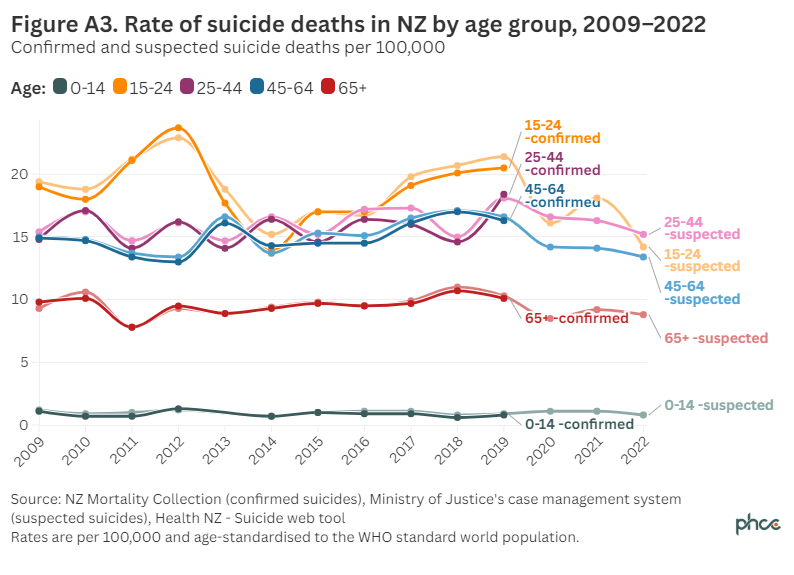References
- Te Whatu Ora, Health New Zealand. Suicide web tool 2024 [Available from: https://www.tewhatuora.govt.nz/for-health-professionals/data-and-statistics/suicide/data-web-tool accessed 10 October 2024.
- World Health Organization. Preventing suicide: A global imperative. Geneva: World Health Organisation 2014. Available from: https://www.who.int/publications/i/item/9789241564779.
- Ministry of Health. Every Life Matters - He Tapu te Oranga o ia Tangata: Suicide Prevention Strategy 2019–2029 and Suicide Prevention Action Plan 2019–2024 for Aotearoa New Zealand. Wellington: Ministry of Health; 2019. Available from: https://www.health.govt.nz/publications/every-life-matters-he-tapu-te-oranga-o-ia-tangata-suicide-prevention-strategy-2019-2029-and-suicide.
- The Lancet Public H. A public health approach to suicide prevention. The Lancet Public Health 2024. doi: 10.1016/S2468-2667(24)00220-2
- Hawton K, Pirkis J. Preventing suicide: a call to action. The Lancet Public Health 2024. doi: 10.1016/S2468-2667(24)00159-2
- Pirkis J, Bantjes J, Dandona R, et al. Addressing key risk factors for suicide at a societal level. The Lancet Public Health 2024. doi: 10.1016/S2468-2667(24)00158-0
- Pirkis J, Dandona R, Silverman M, et al. Preventing suicide: a public health approach to a global problem. The Lancet Public Health 2024. doi: 10.1016/S2468-2667(24)00149-X
- Ortenzi F, Marten R, Valentine NB, et al. Whole of government and whole of society approaches: call for further research to improve population health and health equity. BMJ Global Health 2022;7(7). doi: 10.1136/bmjgh-2022-009972
- Fitzpatrick SJ. Reshaping the ethics of suicide prevention: responsibility, inequality and action on the social determinants of suicide. Public Health Ethics 2018;11(2):179-90. doi: 10.1093/phe/phx022
- Ngā Pou Arawhenua, Child and Youth Mortality Review Committee, Suicide Mortality Review Committee. Te Mauri. The Life Force. Rangatahi suicide report. Te purongo mo te mate whakamomori o te rangatahi. Wellington: Health Quality & Safety Commission; 2020. Available from: https://www.hqsc.govt.nz/resources/resource-library/te-mauri-the-life-force-i-rangatahi-suicide-report-i-te-purongo-mo-te-mate-whakamomori-o-te-rangatahi/.
- van Schalkwyk MC, Collin J, Eddleston M, et al. Conceptualising the commercial determinants of suicide: broadening the lens on suicide and self-harm prevention. The Lancet Psychiatry 2023;10(5):363-70. doi: 10.1016/S2215-0366(23)00043-3
- Fortune S, Sharma V, Papalii T. Evidence Synthesis of the research on Suicide Prevention and Postvention: Aotearoa New Zealand and International Perspectives. . Wellington: Ministry of Health; 2023. Available from: https://www.health.govt.nz/publications/evidence-synthesis-of-the-research-on-suicide-prevention-and-postvention-aotearoa-new-zealand-and.
- Doran CM. The economic cost of suicide and non-fatal suicide behaviour to the New Zealand construction industry and the impact of MATES in Construction in reducing this cost. 2024. Available from: https://mates.net.nz/research/.
- Jenkin G, Atkinson J. Construction Industry Suicides: numbers, characteristics and rates: report prepared for MATES in Construction NZ. Wellington: Suicide and Mental Health Research Group, University of Otago 2021. Available from: https://mates.net.nz/research/.
- Magill R. Work-related suicide: Examining the role of work factors in suicide. Worksafe; 2022. Available from: https://www.worksafe.govt.nz/research/work-related-suicide-examining-the-role-of-work-factors-in-suicide/.
- Lawson-Te Aho Dr KR. The case for Re-framing Māori Suicide Prevention Research in Aotearoa/New Zealand: Applying Lessons from Indigenous Suicide Prevention Research. Journal of Indigenous Research 2017;6(2017):1. doi,
- Nguyen T, Ullah S, Looi JC, et al. Indigenous suicide rates in the United States, Australia and New Zealand between 2006 and 2019. Australian & New Zealand Journal of Psychiatry 2023;57(10):1324-30. doi: https://doi.org/10.1177/00048674231167327
- Durie M. Indigenous suicide: the turamarama declaration. Journal of Indigenous Wellbeing 2017;2(2):59-67. doi, https://journalindigenouswellbeing.co.nz/journal_articles/indigenous-suicide-the-turamarama-declaration/
- Lawson-Te Aho K, McClintock K. Maori Suicide Prevention Research, Policy & Practice. Wellington: University of Otago & Te Rau Ora; 2020. Available from: https://terauora.com/maori-suicide-prevention-research-policy-practice/.
- Coppersmith DD, Nada-Raja S, Beautrais AL. An examination of suicide research and funding in New Zealand 2006–16: implications for new research and policies. Australian Health Review 2017;42(3):356-60. doi: 10.1071/AH16189
- Clapperton A, Spittal MJ, Dwyer J, et al. Suicide within five years of hospital-treated self-harm: A data linkage cohort study. Journal of Affective Disorders 2024;356:528-34. doi: 10.1016/j.jad.2024.04.092
- Platt S, Niederkrotenthaler T. Suicide Prevention Programs. Crisis: The Journal of Crisis Intervention and Suicide Prevention 2020;41. doi: https://doi.org/10.1027/0227-5910/a000671
- Benson R, Rigby J, Brunsdon C, et al. Real-time suicide surveillance: comparison of international surveillance systems and recommended best practice. Archives of Suicide Research 2023;27(4):1312-38. doi: 10.1080/13811118.2022.2131489
- Sutherland G, Milner A, Dwyer J, et al. Implementation and evaluation of the Victorian Suicide Register. Australian and New Zealand Journal of Public Health 2018;42(3):296-302. doi: 10.1111/1753-6405.12725
- Nevarez Flores AG, Martin A, Bartkowiak-Theron I, et al. The impact of suicide registers and other monitoring systems on suicide prevention: A scoping review. International Journal of Social Psychiatry 2024. doi: 10.1177/00207640241261164
- McClintock K, McClintock R. Hoea te waka: Indigenous suicide prevention outcomes framework and evaluation processes-Part 1. Journal of Indigenous Wellbeing 2017;2(2):68-76. doi, https://terauora.com/wp-content/uploads/2022/04/74.70.Hoea-te-waka-Indigenous-suicide-prevention-outcomes-framework-and-evaluation-processes-Part-1.pdf
About the Briefing
Public health expert commentary and analysis on the challenges facing Aotearoa New Zealand and evidence-based solutions.
Subscribe

Public Health Expert Briefing
Get the latest insights from the public health research community delivered straight to your inbox for free. Subscribe to stay up to date with the latest research, analysis and commentary from the Public Health Expert Briefing.
